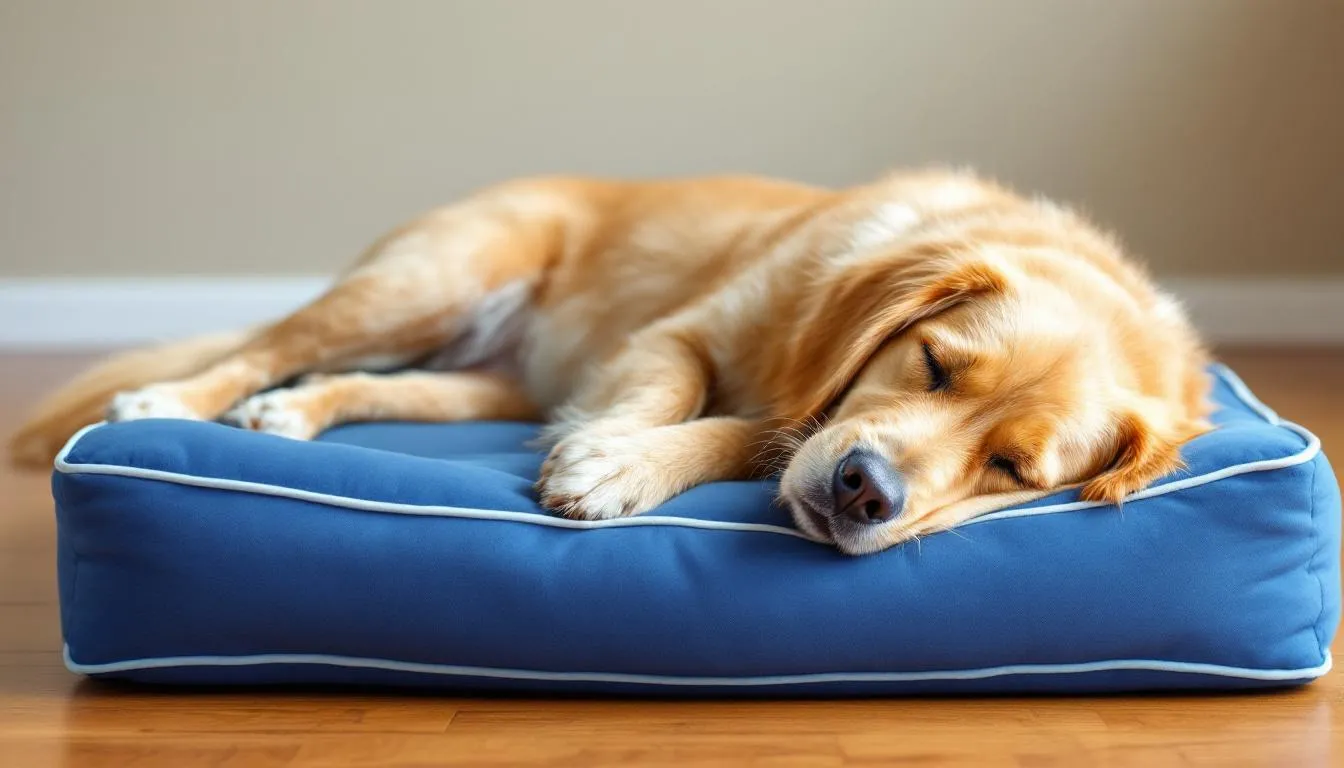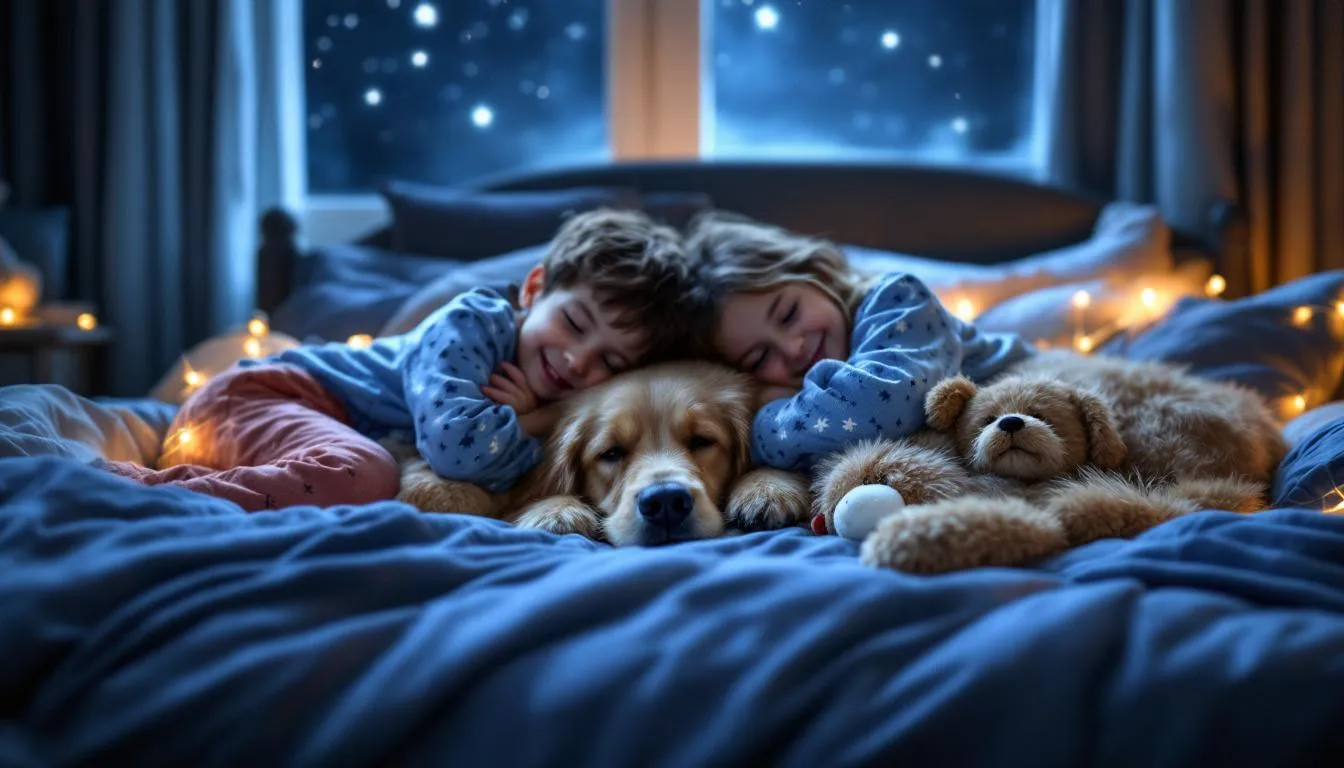Introduction to Dog Sleep
Dogs spend a remarkable portion of their lives sleeping, with adult dogs typically clocking in 12-14 hours of rest each day. This downtime isn’t just about recharging energy—it’s a window into your dog’s comfort, trust, and overall well-being. By observing your dog’s sleeping position, whether they’re a classic side sleeper, stretched out in the superman pose, or curled up in a tight ball, you can gain valuable insights into their emotional state and physical comfort.
Different dog sleeping positions, such as the side sleeper or the alert lion’s pose, reveal how relaxed or secure your furry friend feels in their environment. For example, a dog sleeping sprawled out on their side is likely feeling safe and content, while a dog in the superman pose may be ready to spring into action after a quick nap. Understanding these sleeping positions helps you recognize your dog’s needs and create a supportive, comfortable space for them to rest. By tuning into your dog’s sleep habits, you’re not just a dog lover—you’re an attentive companion helping your dog thrive.
Key Takeaways
Your furry friend’s sleeping position tells a story about comfort, trust, and health that goes far beyond simple rest. What different sleeping positions mean is that each position can reveal insights into a dog's feelings or health. Whether your dog sleeps curled in a tight ball or sprawled out with legs in the air, each position reveals insights into their emotional state, physical comfort, and relationship with their environment.
Understanding different dog sleeping positions helps you become a better dog lover by recognizing when your pooch sleeps peacefully versus when something might be amiss. What each position means is that it signifies something specific about your dog's comfort or sense of security. From the vulnerable belly-up pose that shows complete trust to the protective donut position that conserves body heat, every sleeping position has meaning rooted in canine evolution and domestication.
Dogs sleep roughly 12-14 hours per day, making sleep a significant part of their lives. Adult dogs cycle through different sleep stages just like humans, including deep sleep phases where dreaming occurs. By observing how your dog sleeps, you gain valuable insights into their well-being and can optimize their sleeping environment for better rest.


Most Common Dog Sleeping Positions and Their Meanings
Dogs sleep in remarkably consistent patterns that reflect their wild ancestry and domestic adaptation. While wolves and stray dogs must remain vigilant even during rest, domestic dogs have the luxury of completely relaxing in familiar surroundings. This evolutionary shift explains why house dogs display sleeping positions, or dog lying in various ways, that would be dangerous in the wild.
Each dog’s sleeping position serves specific functions related to temperature regulation, security, and energy conservation. Most common sleeping positions evolved from practical needs - protecting vital organs, conserving warmth, or maintaining alertness. Today’s dogs tend to cycle through multiple positions during sleep, often starting alert and transitioning to more vulnerable poses as they enter deep sleep.
The relationship between sleeping position and trust levels with owners is particularly fascinating. A dog's position suggest their level of trust and comfort in their environment. Dogs who sleep with their belly exposed or legs extended demonstrate profound confidence in their safety. Conversely, dogs sleeping in more protective positions may be adjusting to new environments or feeling less secure.
The Side Sleeper
Side sleeping represents the most common sleeping position among domestic dogs, with research showing 84.2% of dogs regularly sleep stretched out on their side. When dogs lie on their side with legs extended outward, they’re demonstrating deep relaxation and complete trust in their environment. Many dogs settle into the side position as they are falling asleep, preparing for deep rest and comfort.
This position indicates your dog feels safe enough to expose their belly - a vulnerable area that wild canids protect instinctively. Dogs sleeping in this position often enter REM sleep, the deepest phase where dreaming occurs. You might notice your dog’s legs twitching or paddling movements during side sleep, which is completely normal and indicates healthy sleep cycles.
Side sleeping is particularly common among puppies and senior dogs with stiff joints. The position distributes weight evenly and reduces pressure on joints, making it comfortable for dogs with arthritis or mobility issues. Breeds like Golden Retrievers and Greyhounds commonly prefer this position due to their calm temperaments and joint considerations.
When your dog consistently chooses side sleeping, it reflects their comfort level with their surroundings and family. This sleeping position suggests your furry friend has found their safe space and trusts you completely. Adult dogs who suddenly stop side sleeping might be experiencing discomfort and should be evaluated by a veterinarian.


The Curled Up Ball (Donut Position)
The donut position involves dogs curling into a tight ball with their nose touching their hind legs and tail wrapped around their body. This limbs tucked close configuration serves multiple purposes, primarily conserving body heat during cold conditions and providing psychological security.
When dogs sleep curled up, they’re following an ancient survival instinct inherited from their wolf ancestors. This position protects vital organs while minimizing exposed surface area, reducing heat loss significantly. The tight ball formation also provides comfort during stressful situations or when adjusting to new environments.
Smaller breeds like Chihuahuas and Pomeranians frequently use this position due to their higher surface-area-to-volume ratio, making them more susceptible to temperature changes. Dogs prefer this position on cold surfaces or in drafty areas where maintaining body heat becomes priority.
The donut position can indicate your dog needs additional warmth or security. If your usually relaxed dog suddenly starts sleeping curled up, consider whether environmental changes, temperature drops, or stress factors might be influencing their sleep choice. Providing warmer bedding or addressing anxiety sources often helps dogs return to more relaxed sleeping positions.
The Superman (Sploot)
The superman pose involves dogs lying belly-down with front legs stretched forward and back legs extended behind them. This position is particularly popular among puppies and high energy dogs during quick naps between each play session. Puppies often use the superman pose to rest briefly before jumping back into another play session.
Dogs sleep in this position when they’re tired but maintain alertness to their surroundings. The superman pose allows for rapid awakening and immediate readiness for action—perfect for energetic puppies who might want to resume playing at a moment’s notice. The position also helps with temperature regulation by allowing dogs to press their bellies against cool surfaces.
This sleeping position is most common during lighter sleep phases rather than deep sleep. Dogs lying in superman pose can spring into action quickly, making it ideal for short rest periods during active days. Adult dogs occasionally use this position, but it’s predominantly seen in younger, more energetic dogs.
The superman pose indicates your dog is physically tired but mentally engaged with their environment. While sleeping in this position, dogs aren’t reaching the deepest sleep stages, so it shouldn’t be their primary sleep position. If adult dogs consistently choose only this position for sleeping, they might not be getting adequate rest quality.


The Lion’s Pose (Sphinx Position)
The lion pose or sphinx pose involves dogs resting with their head and neck raised, supported by their front paws, while their back legs remain tucked to one side. This position represents light sleeping while maintaining alertness for quick response to stimuli.
Dogs in lion’s pose aren’t sleeping deeply but rather resting while staying ready for immediate action. This position is common among guardian breeds and naturally cautious dogs who prefer monitoring their environment even during rest periods. The position allows maximum air passage for easy breathing while keeping muscles ready for movement.
The sphinx position reflects comfort but not complete relaxation. Dogs choose this pose when they want to rest but don’t feel secure enough for vulnerable positions. New dogs in unfamiliar homes often sleep this way initially, gradually transitioning to more relaxed positions as they become comfortable.
If your dog frequently sleeps in lion’s pose rather than deeper sleeping positions, they might be experiencing anxiety or feeling responsible for household security. Creating a more secure environment or addressing underlying stress can help dogs transition to more restful sleeping positions.
Belly Up Sleeping
Belly up sleeping, sometimes called the “dying cockroach” position, involves dogs sleeping on their back with legs in the air and belly fully exposed. This position exposes all the body parts, allowing for maximum air passage and indicating relaxation and openness. This vulnerable position demonstrates complete trust and security in their environment, as exposing the belly makes dogs completely defenseless.
This sleeping position serves excellent temperature regulation purposes. Dogs’ belly fur is typically thinner than elsewhere, and exposing this area helps release excess body heat. During warm weather, many dogs prefer sleeping with bellies fully exposed to cool down effectively.
The belly up position indicates the ultimate comfort level and trust in surroundings. Dogs sleeping this way feel completely safe and secure with their family. This position typically occurs during the deepest sleep phases and often accompanies vivid dreaming, evidenced by leg movements and vocalizations.
Senior dogs may gradually decrease belly up sleeping due to joint discomfort or breathing issues that make lying on their back uncomfortable. If your dog suddenly stops sleeping in this position after regularly doing so, consider veterinary evaluation to rule out physical discomfort or health changes.


The Cuddler and Back-to-Back Positions
The cuddler position involves dogs sleeping directly on or against their owners and other pets, expressing strong bonding, affection, and pack mentality. Dogs who sleep pressed against family members are following instincts from their puppyhood when littermates slept together for warmth and security.
Back-to-back sleeping with owners or other dogs provides security and warmth while maintaining some independence. This position satisfies dogs’ need for connection while allowing comfortable rest. Breeds known for strong bonding tendencies, like Cavalier King Charles Spaniels, commonly prefer cuddler positions.
When your dog cuddled against you during sleep, they’re demonstrating trust and desire for closeness with family members. This behavior reinforces the human-dog bond and provides mutual comfort. Many dogs find physical contact with trusted humans deeply calming and security-enhancing. These affectionate moments, often called dog snuggles, highlight your dog's loving nature and help reduce anxiety for both pet and owner.
Some dogs become cuddle bugs who consistently seek contact during sleep, snuggling up on top of their owners or other dogs to show affection and a sense of security, while others prefer occasional closeness. Sudden changes in cuddling behavior - either increased neediness or withdrawal from contact - might indicate emotional or physical changes requiring attention.
The Burrower
The burrower bug position involves dogs hiding under blankets, pillows, or other soft materials, creating enclosed spaces that provide warmth, comfort, and security. This behavior mimics natural denning instincts and provides gentle pressure therapy that reduces anxiety.
Dogs seek burrowing opportunities when they need extra security or warmth. The enclosed space created by blankets or bedding materials offers psychological comfort similar to natural den environments. Many dogs find the gentle pressure of covering materials calming and sleep-promoting.
Small breeds and anxious dogs particularly enjoy burrowing, as the enclosed space helps them feel protected and warm. The behavior is completely normal and indicates your dog has found a self-soothing method that promotes better sleep quality.
Providing appropriate burrowing opportunities, such as blankets or covered beds, supports dogs who prefer this sleeping style. However, ensure adequate ventilation and monitor for overheating, especially during warm weather or with thick-coated breeds.
Head and Neck Positions: What They Indicate
A dog’s head and neck position during sleep can speak volumes about their comfort and health. When a dog sleeps with their head and neck raised, it often means they’re trying to make breathing easier—this is especially common in dogs with respiratory issues or older dogs who may have developed breathing difficulties. The neck raised position can also signal that your dog is staying alert, ready to respond to any changes in their environment even while resting.
On the other hand, if your dog sleeps with their head and neck fully relaxed and resting on the bed or floor, it’s a sign they feel completely safe and at ease. This relaxed posture is a good indicator that your dog trusts their surroundings and is enjoying a deep, restorative sleep. By paying attention to these subtle sleeping habits, you can spot early signs of discomfort or health issues and make adjustments—like providing a supportive dog bed or consulting your vet—to ensure your dog sleeps comfortably and soundly.
Temperature-Related Sleeping Positions
Temperature significantly influences how dogs sleep, with position choices directly reflecting their thermal comfort needs. Dogs sleeping on cold surfaces like tile floors or concrete are actively seeking cooling, while those curled tightly are conserving warmth.
During hot weather, dogs often sprawl out on cool surfaces with bellies partly exposed or fully exposed to maximize heat dissipation. The head and neck raised position also improves airflow and breathing during warm conditions. These adaptations help dogs regulate body temperature since they can’t sweat like humans.
Cold weather prompts dogs to seek warm spots and adopt heat-conserving positions. You might notice your dog gravitating toward sunny spots, heating vents, or warm bedding during cooler periods. The tight ball position becomes more common as temperatures drop.
Observing your dog’s temperature-related position choices helps you optimize their sleeping environment. Providing both warm and cool sleeping options allows dogs to self-regulate their comfort throughout different seasons and daily temperature variations.
Puppy Sleep: How Young Dogs Rest Differently
Puppies are champions when it comes to sleep, often snoozing for 18-20 hours a day. Unlike adult dogs, puppies experience frequent naps and shorter bursts of deep sleep as their bodies and brains develop. These different dog sleeping positions and patterns are essential for healthy growth, learning, and emotional stability.
As puppies grow, their sleep habits gradually shift to resemble those of adult dogs, with longer stretches of deep sleep and fewer naps. During this stage, puppies may prefer cozy, enclosed spaces like a crate or a soft puppy bed, which mimic the security of a den and help them feel safe. Understanding your puppy’s unique sleep needs allows you to create a nurturing environment that supports their development—think soft bedding, a quiet space, and plenty of opportunities for rest between play sessions. By respecting your puppy’s need for deep sleep, you’re setting the stage for a happy, healthy adult dog.
Dog Sleep and Age: Changes Over a Lifetime
As dogs age, their sleeping patterns and preferences naturally evolve. Puppies, with their boundless energy and rapid growth, need more sleep than any other age group. Adult dogs typically settle into a routine of 12-14 hours of sleep per day, but as dogs age into their senior years, you may notice them sleeping more during the day and sometimes less at night.
Health issues like arthritis, joint pain, or breathing problems can also influence how and where your dog prefers to sleep. Senior dogs, for example, may benefit from a supportive orthopedic dog bed that cushions stiff joints and makes it easier to get comfortable. Meanwhile, adult dogs might enjoy a variety of sleeping positions and locations, depending on their health and personality. By recognizing these changes and adjusting your dog’s sleeping environment—whether it’s upgrading to a more comfortable dog bed or providing extra warmth for older dogs—you can help your furry friend sleep comfortably at every stage of life.


Understanding Your Dog’s Sleep Patterns and Behaviors
Normal sleep duration varies significantly with age, with puppies requiring 18-20 hours daily, adult dogs needing 12-14 hours, and senior dogs often needing additional rest due to age-related changes. Like human babies, puppies need this much sleep to support healthy development and growth, making adequate rest crucial for their well-being. Understanding these patterns helps you recognize when your dog’s sleeping habits fall within normal ranges.
Common sleep behaviors include twitching, dreaming, and sleep running movements during REM phases. These behaviors indicate healthy sleep cycles and brain activity. Rapid eye movement sleep is essential for memory consolidation and emotional processing in dogs, just as in humans.
Many dogs circle and dig at their sleeping area before settling down, following instinctive behaviors inherited from wild ancestors who prepared safe sleeping spots. This behavior is perfectly normal and helps dogs create comfortable sleeping arrangements.
Snoring patterns vary among breeds, with brachycephalic dogs (those with shortened muzzles) naturally snoring more due to their airway structure. However, sudden changes in snoring intensity or new breathing issues during sleep warrant veterinary evaluation.
Owner Interaction and Dog Sleep: How Your Bond Affects Rest
The relationship you share with your dog plays a big role in how—and where—they choose to sleep. Many dogs sleep best when they feel close to their owners, often seeking out the cuddler position or snuggling up on the bed or couch. This desire for closeness is rooted in the pack mentality, where sleeping together provides warmth, security, and a sense of belonging.
Some dogs are true cuddle bugs, always looking for a chance to snuggle, while others may prefer a bit more independence, choosing to sleep in their own dog bed or a quiet corner. By observing your dog’s preferred sleeping positions—whether it’s the cuddler position, back-to-back, or solo—you can better understand their needs and strengthen your bond. Providing a comfortable dog bed in your bedroom or a cozy spot nearby can help your dog feel secure, while respecting their space if they prefer to sleep alone supports their independence. Ultimately, tuning into your dog’s sleeping habits and preferences is a wonderful way to show you care and ensure your furry friend gets the restful sleep they deserve.
Creating the Optimal Sleep Environment for Your Dog
Choosing appropriate bed types for different sleeping positions enhances your dog’s sleep quality significantly. Providing the right environment and understanding your dog's sleeping positions ensures they achieve the best sleep possible. Side sleepers benefit from supportive orthopedic beds that cushion joints, while dogs who prefer curling up enjoy raised-edge beds that provide security and warmth.
Temperature control plays a crucial role in sleep quality. Ensure your dog’s sleeping area maintains comfortable temperatures year-round, with options for both warming and cooling as needed. Proper ventilation prevents overheating while adequate insulation protects against drafts.
Placement of water, toys, and comfort items near the sleeping area supports your dog’s nighttime needs without requiring major position changes. However, avoid placing food near sleep areas, as this can create excitement that interferes with rest.
Establishing consistent bedtime routines helps dogs fall asleep more easily and sleep more deeply. Regular sleep schedules, calming pre-sleep activities, and consistent sleeping locations all contribute to better sleep quality and more predictable sleeping patterns.
When sleep position changes occur suddenly or your dog shows signs of discomfort during sleep, consult your veterinarian. Changes in sleeping habits can indicate health issues, particularly in older dogs who may develop joint problems or other age-related conditions affecting comfort.
FAQ
Why does my dog keep changing sleeping positions throughout the night?
Dogs naturally cycle through different sleep stages throughout the night, and position changes often correspond to these cycles. Light sleep phases may involve more alert positions like the lion’s pose, while deep sleep allows for more vulnerable positions like side sleeping or belly up. Temperature regulation also drives position changes - dogs may start curled up when cool and stretch out as they warm up during sleep.
Is it normal for my dog to snore loudly in certain positions?
Some snoring is normal, especially in brachycephalic breeds with shortened airways. However, position-related snoring changes can indicate airway obstruction. If your dog only snores in specific positions or develops new snoring patterns, this might signal breathing issues requiring veterinary evaluation. Dogs with breathing problems often sleep with their head and neck raised to improve airflow.
Should I be concerned if my senior dog suddenly prefers sleeping with head elevated?
Yes, sudden preference for elevated head positions in older dogs can indicate breathing issues, heart problems, or other age-related health concerns. Senior dogs may develop conditions that make lying flat uncomfortable or difficult. Schedule a veterinary consultation to rule out underlying health issues and discuss appropriate support for comfortable sleeping.
Can I train my dog to sleep in a specific position or location?
While you can encourage specific sleeping locations through positive reinforcement and comfortable bedding, sleeping positions are largely instinctive and comfort-driven. Focus on creating an optimal environment rather than forcing specific positions. Dogs will naturally choose positions that meet their temperature, security, and comfort needs.
What does it mean if my usually cuddly dog starts sleeping alone?
Sudden changes from social sleeping to solitary sleeping can indicate various factors including physical discomfort, illness, stress, or environmental changes. Dogs experiencing pain may prefer sleeping alone to avoid accidental contact that causes discomfort. Monitor for other behavioral changes and consult your veterinarian if the change persists or accompanies other concerning symptoms.
FAQ
Why does my dog keep changing sleeping positions throughout the night?
Dogs naturally cycle through different sleep stages throughout the night, and position changes often correspond to these cycles. Light sleep phases may involve more alert positions like the lion’s pose, while deep sleep allows for more vulnerable positions like side sleeping or belly up. Temperature regulation also drives position changes - dogs may start curled up when cool and stretch out as they warm up during sleep.
Is it normal for my dog to snore loudly in certain positions?
Some snoring is normal, especially in brachycephalic breeds with shortened airways. However, position-related snoring changes can indicate airway obstruction. If your dog only snores in specific positions or develops new snoring patterns, this might signal breathing issues requiring veterinary evaluation. Dogs with breathing problems often sleep with their head and neck raised to improve airflow.
Should I be concerned if my senior dog suddenly prefers sleeping with head elevated?
Yes, sudden preference for elevated head positions in older dogs can indicate breathing issues, heart problems, or other age-related health concerns. Senior dogs may develop conditions that make lying flat uncomfortable or difficult. Schedule a veterinary consultation to rule out underlying health issues and discuss appropriate support for comfortable sleeping.
Can I train my dog to sleep in a specific position or location?
While you can encourage specific sleeping locations through positive reinforcement and comfortable bedding, sleeping positions are largely instinctive and comfort-driven. Focus on creating an optimal environment rather than forcing specific positions. Dogs will naturally choose positions that meet their temperature, security, and comfort needs.
What does it mean if my usually cuddly dog starts sleeping alone?
Sudden changes from social sleeping to solitary sleeping can indicate various factors including physical discomfort, illness, stress, or environmental changes. Dogs experiencing pain may prefer sleeping alone to avoid accidental contact that causes discomfort. Monitor for other behavioral changes and consult your veterinarian if the change persists or accompanies other concerning symptoms.






